| Article ID | Journal | Published Year | Pages | File Type |
|---|---|---|---|---|
| 8502117 | Livestock Science | 2017 | 21 Pages |
Abstract
Different breeding strategies targeting two indigenous cattle breeds of Ethiopia (Borana and Horro) were evaluated with the objective of developing appropriate breeding programs that would maximize production and productivity of the breeds maintained on pastures using a deterministic approach. Borana was evaluated for beef, milk and both for beef and milk (dual purpose) while Horro was evaluated for milk and dual purposes. Two units, breeding unit and production unit, consisting of six selection groups were defined for both breeds. Selection criteria used were yearling weight, milk yield, age at first calving, calving interval and calf survival to yearling for dual purpose program and milk yield, age at first calving, calving interval and calf survival to yearling for milk production program. In addition, yearling weight, age at first calving, calving interval and calf survival to yearling were used to improve beef production in Borana breed. Three different levels of breeding bull selection proportions (5%, 10%, and 15%) were used. For all goal traits investigated, more genetic gains were obtained from bull selection groups than the cow selection groups. The bull selection groups also had the shortest generation interval compared to the cow groups (4.07 vs. 6.42 years). From the estimated annual genetic gains for the individual goal traits, all traits had favorable genetic gains except age at first calving. Genetic gains per year were highest for milk yield followed by live weight. Genetic gains were near zero for the other traits. Nearly comparable annual genetic gains were estimated for both Borana and Horro cattle breeds assumed for milk improvement program under different selection proportions. Estimated genetic improvements of about 291.96, 268.63 and 252.73Â l of milk were simulated for Borana in 5%, 10% and 15% breeding bull selection proportion. The corresponding improvements for Horro were 291.55, 268.31 and 252.43Â l. However, gains were higher in Borana when the two cattle breeds are assumed for dual purpose program (85.92-98.64 for Borana Vs 78.14-90.26 for Horro). Estimated genetic improvements for live weight ranged from 38.96 to 45.11Â kg for Borana and 34.17-39.46Â kg for Horro when both cattle breeds investigated for dual purpose program. In the current study information is lacking on economic values for each goal trait. Thus, further works are warranted. Except for age at first calving, the genetic gain per year in yearling weight, milk yield, calving interval and survival to yearling obtained from the different options are satisfactory and can result in reasonable genetic improvements of these cattle breeds.
Keywords
Related Topics
Life Sciences
Agricultural and Biological Sciences
Animal Science and Zoology
Authors
Ayele Mandefro, Gemeda Duguma, Tadele Mirkena, Hailu Dadi,
